Four charges are arranged at the corners of the square PQRS of side a as shown in the figure . (a) Find the work required to assemble these charges in the given configuration . (b) Suppose a charge q is brought to the center of the square by keeping the four charges fixed at the corners how much extra work is required for this ?
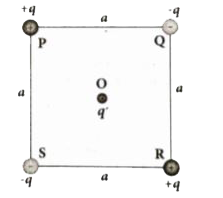 Solution in Tamil
Solution in Tamil
(a) The work done to arrange the charges in the corners of the square is independent of the way they are arranged . We can follow any order.
(i) First the charge +q is brought to the corner P . This requires no work since no charge is already present Wp = 0
(ii) Work required to bring the charge −q to the corner Q =(−q)× potential at a point Q due to +q located at a point P . WQ=−q×14πε0qq=−14πε0q2a
(iii) Work required tpo bring the charge +q to the corner R q× potential at the point R due to charges at the point P and Q .
Wr=q×14πε0(−qa+q√2a)=14πε0q2a(−1+1√2)
(iv) Work required to bring the fourth charge -q at the position S = q× potential at the point S due the all the three charges at the three charges at the point P,Q and R .
Ws=−q×14πε0(qa+qa−q√a)=−14πεqa(2−1√2)
(b) Work required to bring the charge q to the center of the square =q × potential at the center point O due to tall the four charges in the four corners . The potential created by the two +q charges are canceled by the potential created by the -q charges which are located in the opposite corners . Therefore the net electric potential at the center O due to all the charges in the corners is zero . Hence no work no work is required to bring any charge to the point O . Physically this implies that if any charge q when brought close to O then it moves to the point O without any external force.
Topper's Solved these Questions
- BOOK - FULL MARKSCHAPTER - ELECTROSTATICS EXERCISE - Textual Evaluation Solved (Multiple choice questions : )15videos
ELECTROSTATICS
- BOOK - FULL MARKSCHAPTER - ELECTROSTATICS EXERCISE - Textual Evaluation Solved (II. Short Answer Questions : )21videos
ELECTROSTATICS
- BOOK - FULL MARKSCHAPTER - DUAL NATURE OF RADIATION AND MATTEREXERCISE - ADDITIONAL QUESTIONS -( ADDITIONAL NUMERICAL PROBLEMS : )10videos
DUAL NATURE OF RADIATION AND MATTER
- BOOK - FULL MARKSCHAPTER - MAGNETISM AND MAGNETIC EFFECTS OF ELECTRIC CURRENT EXERCISE - ADDITIONAL QUESTIONS SOLVED - NUMERICAL PROBLEMS :4videos
MAGNETISM AND MAGNETIC EFFECTS OF ELECTRIC CURRENT
Similar Questions
Two identical point charges'of magnitude -q are fixed as shown in the figure below. A third charge +q is placed midway between the two charges at the point P. Suppose this charge is displaced a small distance from the point P in the directions indicated by the arrows, in which direction(s) will +q be stable with respect to the displacement?
 05:30View Solution
05:30View SolutionWhat is meant by quantisation of charges ?
02:49View SolutionIf a light of wavelength 4950 Å is viewed as a continuous flow of photons, what is the energy of each photon in eV ? (Given h=6.6×10−34Js, c =3×108ms−1)
07:04View SolutionThe radius of the first orbit of hydrogen atom is 0.5 Å. The electron moves is an orbit with a uniform speed of 2.2×106ms−1. What is the magnetic field produced at the centre of the uncleus due to the mation of this electron ? Use μ0=4π×10−7Hm−1 and electric charge =1.6×10−19 C
08:16View SolutionFour charges are arranged at the corners of a square ABCD pf side d, as shown in Fig. Find the work required to put together this arrangement (b) A charge q0 brought to the center E of the square, the four charges being held fixed at the corners . How much extra work in needed to do this ?
 04:17View Solution
04:17View SolutionFour charges + q, –q, + q and –q are put together on four corners of a square as shown in figure. The work done by external agent in slowly assembling this configuration is
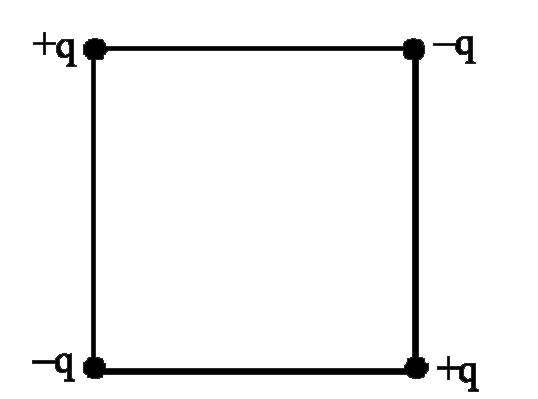 09:20View Solution
09:20View Solutionचित्र 2.15 में दर्शाए अनुशार चार आवेश भुजा d वाले किसी वर्ग ABCD के शीर्षों पर व्यवस्थित किए गए हैं। (a) इस व्यवस्था को एक साथ बनाने में किया गया कार्य ज्ञात कीजिए । (b) कोई आवेश q0 वर्ग के केंद्र E पर लाया जाता है तथा चारों आवेश अपने शीर्षों पर दृढ़ रहते हैं । ऐसा करने के लिए कितना अतिरिक्त कार्य करना पड़ता है ?
 03:06View Solution
03:06View SolutionFour charges are arranged at the corners of a square ABCD of side d. as shown in fig. Find the work required to put together this arrangement. (b) A charge q0 is brought to the centre of the square, the four being held fixed at its corners. How much extra work is needed to do this ?
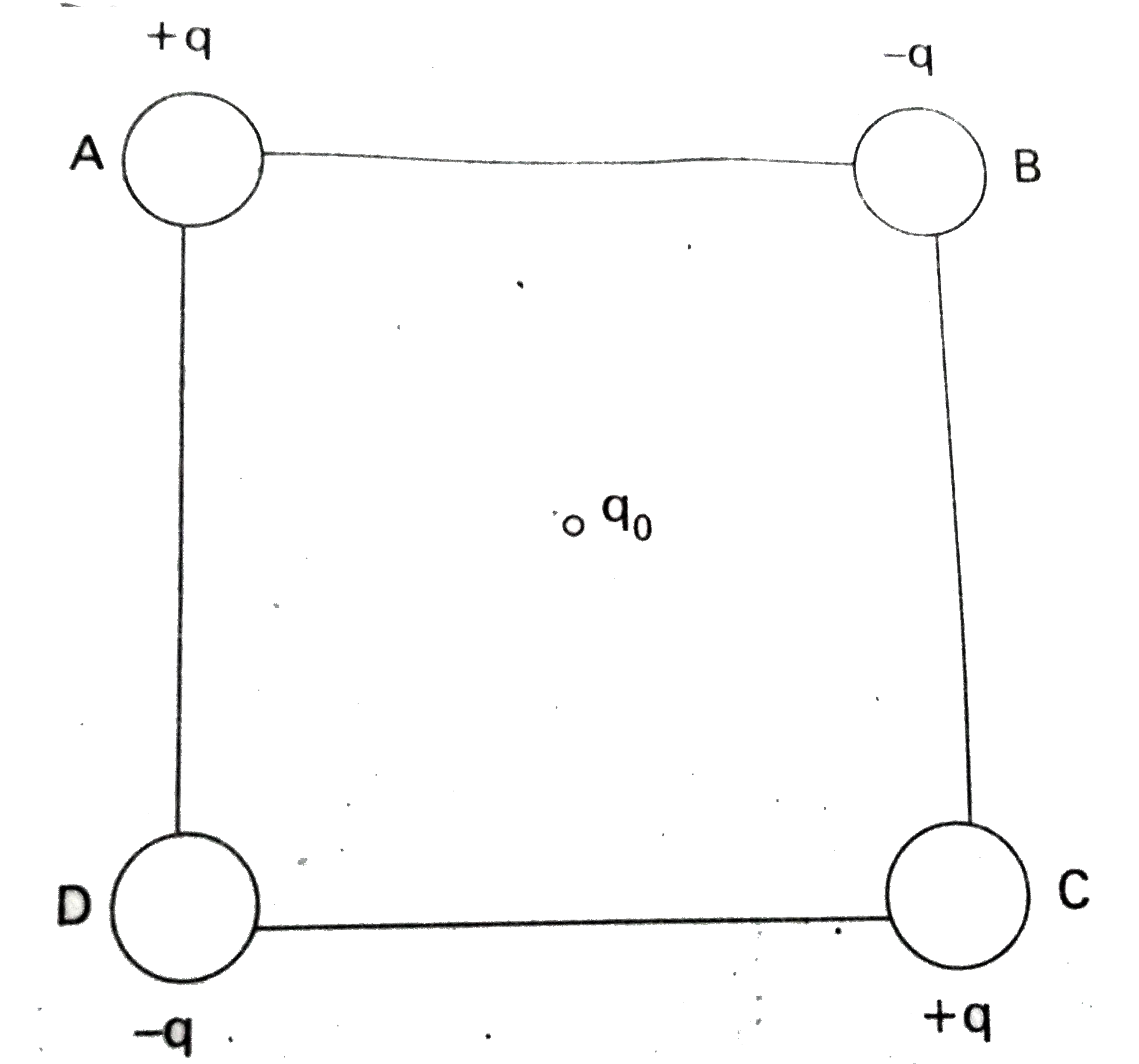 08:10View Solution
08:10View SolutionThe work which is required to be done to make an arrangement of four paritcles each having a charge +q such that the particles lie at the four corners of a square of side a is
04:06View Solutionचित्र में दर्शाए अनुसार चार आवेश d भुजा वाले किसी वर्ग ABCD के शीर्षों पर व्यवस्थित किए गए है । (a). इस व्यवस्था को एक साथ बनाने में किया गया कार्य ज्ञात कीजिए (b) कोई आवेश q0 वर्ग के केंद्र E पर लाया जाता है तथा चारों आवेश अपने शीर्षों पर दृढ़ रहते हैं। ऐसा करने के लिए कितना अतिरिक्त कार्य करना पड़ता है?
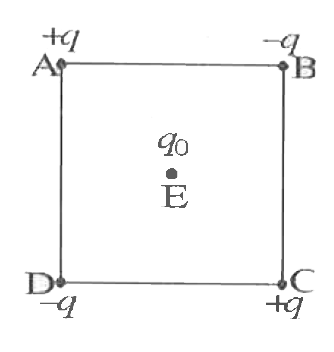 04:03View Solution
04:03View Solutionचित्र में 5μC के बिन्दु आवेश को एक वर्ग ABCD के कोने A से कोने B तक ले जाने में कितना कार्य करना पड़ेगा यदि वर्ग के केन्द्र पर 10μC आवेश रखा हो ?
 05:48View Solution
05:48View SolutionFour charges are arranged at the comers of a square ABCD of side d, as shown in Fig.
a. Find the work required to put together this arrangement
b. A charge q0 is brought to the centre E of the square, the four charges being held fixed at its corners. How much extra work is needed to do this?n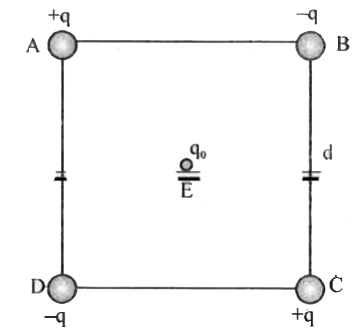 09:23View Solution
09:23View SolutionFour charges are arranged at the corners of a square ABCD of side d, as shown in Fig. 2.15.(a) Find the work required to put together this arrangement. (b) A charge q_(0) is brought to the centre E of the square, the four charges being held fixed at its corners. How much extra work is needed to do this?
02:55View SolutionFour charges are arranged at the corners of a square ABCD of side d, as shown in Fig. Find the work required to put together this arrangement (b) A charge q_(0) brought to the center E of the square, the four charges being held fixed at the corners . How much extra work in needed to do this ?
04:24View Solutionप्रत्येक चार समान आवेशों q को किसी a भुजा के वर्ग के चारों कोनों पर रखा जाता है। इसके केन्द्र से अनंत तक -q आवेश को लाने में किया गया कार्य क्या होगा?
04:43View Solution

